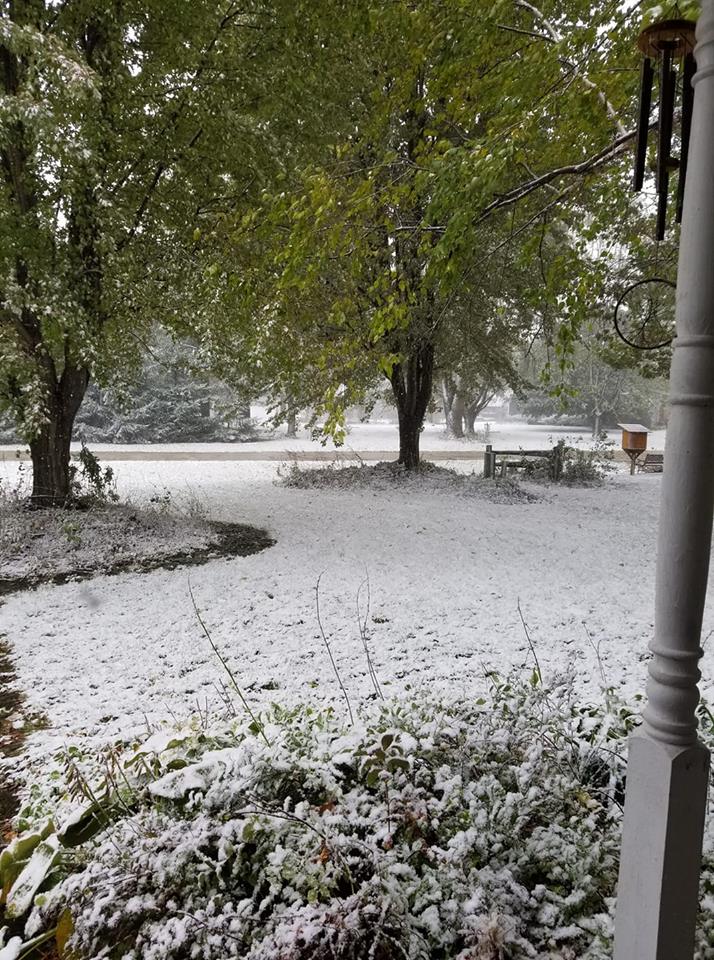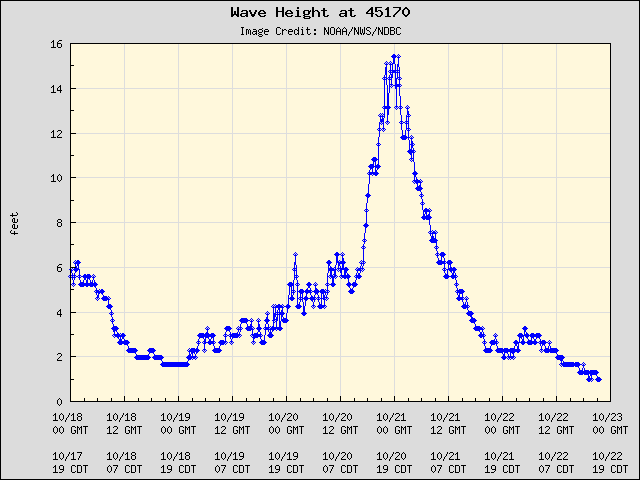
A rapidly-intensifying storm is expected to bring heavy snow, blizzard conditions, and icing from the Upper Midwest through the Great Lakes and Northeast. Scattered severe thunderstorms may produce severe/damaging wind gusts and a couple of tornadoes across parts of the Midwest and lower Ohio Valley through the evening. Arctic air will expand across the central and southern U.S.. Read More >
Overview
Wind:
 |
 |
| Peak wind gusts at select automated observation sites | Peak wind gusts overlaid on late morning satellite water vapor imagery |
Peak Wind Gusts
Public Information Statement National Weather Service Chicago IL 648 PM CDT Sat Oct 20 2018 ...Highest Wind Gusts at Automated Stations on October 20th... Location Speed Time/Date Provider Michigan City C-man 65 MPH 0534 PM 10/20 MARITIME Rockford Arpt. 61 MPH 1246 PM 10/20 ASOS Chicago OHare 61 MPH 0137 PM 10/20 ASOS Chicago Midway 60 MPH 0156 PM 10/20 ASOS Romeoville - Lewis Airport 60 MPH 0155 PM 10/20 AWOS 3 N Poplar Grove 59 MPH 0200 PM 10/20 CWOP West Chicago - DuPage Arpt 58 MPH 0128 PM 10/20 ASOS 2 W Mount Morris 55 MPH 0200 PM 10/20 CWOP Sugar Grove - Aurora Arpt. 54 MPH 0300 PM 10/20 ASOS 3 ENE Roscoe 53 MPH 0241 PM 10/20 CWOP Waukegan Harbor 53 MPH 0230 PM 10/20 NWS-GLOS Kankakee Airport 52 MPH 0235 PM 10/20 AWOS Chicago Crib 51 MPH 0410 PM 10/20 MARITIME 1 SE Winnebago 51 MPH 0240 PM 10/20 CWOP Peotone 51 MPH 0220 PM 10/20 CWOP Michigan City Buoy 49 MPH 0530 PM 10/20 MARITIME Pontiac Airport 49 MPH 0115 PM 10/20 AWOS Peru Airport 49 MPH 0115 PM 10/20 AWOS Burns Harbor 48 MPH 0510 PM 10/20 NWS-GLOS Gary Airport 48 MPH 0345 PM 10/20 AWOS 5 E Ashkum 47 MPH 0252 PM 10/20 CWOP 1 SW Saint Charles 47 MPH 0145 PM 10/20 CWOP Rensselaer Airport 47 MPH 0315 PM 10/20 AWOS Rosemont 46 MPH 0145 PM 10/20 CWOP Wheeling - Chi Exec Airport 46 MPH 0324 PM 10/20 ASOS 2 W Huntley 46 MPH 0228 PM 10/20 CWOP Joliet Airport 46 MPH 0215 PM 10/20 AWOS 2 NW Bolingbrook 45 MPH 0310 PM 10/20 CWOP Hyde Park 45 MPH 0215 PM 10/20 NONFEDAWOS Valparaiso Airport 45 MPH 1217 PM 10/20 ASOS Wilmette Buoy 45 MPH 0310 PM 10/20 MARITIME 2 NE Bradley 45 MPH 0238 PM 10/20 CWOP Rochelle Airport 44 MPH 0235 PM 10/20 AWOS 4 ESE Beecher 43 MPH 0230 PM 10/20 CWOP 1 NNE Crystal Lake 43 MPH 0214 PM 10/20 CWOP 1 NNW Woodridge 42 MPH 0146 PM 10/20 CWOP 2 WNW Dixon 42 MPH 0239 PM 10/20 CWOP Mount Prospect 42 MPH 0130 PM 10/20 MESOWEST 1 ENE Bonfield 42 MPH 0230 PM 10/20 CWOP Morris Airport 41 MPH 1215 PM 10/20 AWOS 2 N Utica 41 MPH 0301 PM 10/20 CWOP 1 W Gibson City 41 MPH 0312 PM 10/20 CWOP 2 W Geneva 41 MPH 0245 PM 10/20 MESOWEST 1 NNE Wonder Lake 41 MPH 1255 PM 10/20 CWOP Lansing Airport 41 MPH 0235 PM 10/20 AWOS Frankfort 40 MPH 0213 PM 10/20 CWOP 1 ENE Logan Square 40 MPH 0154 PM 10/20 URBANET Lansing 40 MPH 0229 PM 10/20 URBANET 2 N Shorewood 40 MPH 0324 PM 10/20 CWOP Porter 40 MPH 0317 PM 10/20 RAWS Waukegan Airport 40 MPH 1106 AM 10/20 ASOS De Kalb Arpt. 39 MPH 1035 AM 10/20 AWOS Observations are collected from a variety of sources with varying equipment and exposures. Not all data listed are considered official. $$
Photos:
 |
 |
 |
 |
 |
 |
| Sycamore, IL Emily Kerkett James via Bob Wazsak |
Sycamore, IL Josh James via Bob Wazsak |
Somonauk, IL Bob Wazsak |
St. Charles/ Campton Hills Geri Wilson via Bob Wazsak |
Michigan City, IN beach webcam at 5:30 pm CDT showing large waves |
Westchester, IL |
Radar:
Fast-Moving Snow Squalls, Mixed With Graupel and Rain
 |
| Radar Mosaic Loop from 10am to 4pm CDT. While the colors indicate rain, the heavier areas were leading to rapid cooling of the atmosphere, allowing for snow and/or graupel to reach the ground. |
Storm Reports
 |
| Storm reports of strong and damaging winds. |
PRELIMINARY LOCAL STORM REPORT...SUMMARY
NATIONAL WEATHER SERVICE CHICAGO/ROMEOVILLE IL
625 PM CDT SAT OCT 20 2018
..TIME... ...EVENT... ...CITY LOCATION... ...LAT.LON...
..DATE... ....MAG.... ..COUNTY LOCATION..ST.. ...SOURCE....
..REMARKS..
0415 PM NON-TSTM WND DMG SHELDON 40.77N 87.57W
10/20/2018 IROQUOIS IL EMERGENCY MNGR
SIDING BLOWN OFF ON THE WEST SIDE OF A RESIDENCE.
0320 PM NON-TSTM WND DMG 4 SW PLAINFIELD 41.57N 88.26W
10/20/2018 KENDALL IL PUBLIC
2 SMALL TREES DOWNED IN FAR SOUTHWEST PLAINFIELD. RELAYED
VIA TWITTER.
0304 PM NON-TSTM WND GST SOMONAUK 41.63N 88.68W
10/20/2018 M65.00 MPH DE KALB IL TRAINED SPOTTER
RECORDED ON HOME WEATHER STATION. WIND KNOCKED OVER
FENCE. REPORT RELAYED VIA TWITTER.
0255 PM NON-TSTM WND DMG BEAVERVILLE 40.95N 87.65W
10/20/2018 IROQUOIS IL PUBLIC
LARGE TREE BRANCH BROKEN OFF...RELAYED VIA ILX FACEBOOK.
0224 PM NON-TSTM WND DMG HIGHLAND 41.55N 87.46W
10/20/2018 LAKE IN TRAINED SPOTTER
LARGE TREE LIMBS ESTIMATED 7 INCH DIAMTER DOWN ON RIDGE
ROAD AND INDIANAPOLIS AT WICKER PARK.
0220 PM NON-TSTM WND DMG STEGER 41.47N 87.64W
10/20/2018 WILL IL EMERGENCY MNGR
MULTIPLE TREES DOWN/SNAPPED...SOME ACROSS ROADS AND ONE
THAT DAMAGED A HOUSE. TIME ESTIMATED.
0211 PM NON-TSTM WND DMG PARK RIDGE 42.01N 87.84W
10/20/2018 COOK IL PUBLIC
VERY LARGE DISEASED TREE SNAPPED. RELAYED VIA TWITTER.
0210 PM NON-TSTM WND DMG SOMONAUK 41.63N 88.68W
10/20/2018 DE KALB IL TRAINED SPOTTER
MEDIUM SIZE TREE APPROX 8 TO 12 INCH DIAMETER UPROOTED.
TIME ESTIMATED.
0200 PM NON-TSTM WND DMG CREST HILL 41.57N 88.11W
10/20/2018 WILL IL TRAINED SPOTTER
LARGE TREE UPROOTED ON RT 53 IN CREST HILL. ROOT SYSTEM
LIFTED UP UNDERNEATH GARAGE LIFTING GARAGE OFF FOUNDATION
CAUSING EXTENSIVE DAMAGE TO BUILDING. PICTURE VIA
TWITTER. TIME ESTIMATED.
0157 PM NON-TSTM WND GST ROMEOVILLE 41.65N 88.09W
10/20/2018 M55.00 MPH WILL IL OFFICIAL NWS OBS
HEAVY SNOW SQUALL WITH 55 MPH WIND AND APPROX 1/4 MILE
VISIBILITY AT NWS CHICAGO.
0156 PM NON-TSTM WND GST MIDWAY AIRPORT 41.78N 87.75W
10/20/2018 M60.00 MPH COOK IL ASOS
RAIN/SNOW SQUALL.
0155 PM NON-TSTM WND GST 3 SW MIDWAY AIRPORT 41.75N 87.79W
10/20/2018 M63.00 MPH COOK IL CO-OP OBSERVER
MEASURED 63 MPH WIND GUST WITH RAIN/SNOW SQUALL.
0155 PM NON-TSTM WND GST 3 WNW LOCKPORT 41.61N 88.10W
10/20/2018 M60.00 MPH WILL IL AWOS
60 MPH WIND MEASURED AT KLOT.
0152 PM NON-TSTM WND DMG LOCKPORT 41.59N 88.05W
10/20/2018 WILL IL PUBLIC
LARGE TREE BRANCH SNAPPED OFF AND FELL ONTO A GARAGE.
RELAYED VIA TWITTER. TIME ESTIMATED BY RADAR.
0140 PM NON-TSTM WND DMG LISLE 41.79N 88.09W
10/20/2018 DUPAGE IL TRAINED SPOTTER
LARGE TREE 12 TO 18 INCHES IN DIAMETER AND 8 TO 10 INCH
DIAMETER TREE BRANCHES DOWNED ON A PRIVATE PROPERTY.
REPORTED RELAYED VIA TWITTER. TIME ESTIMATED BY RADAR.
0140 PM NON-TSTM WND DMG WESTCHESTER 41.85N 87.89W
10/20/2018 COOK IL PUBLIC
LARGE TREE APPOX 12-18 INCH DIAMETER UPROOTED IN
WESTCHESTER. TIME ESTIMATED FROM RADAR.
0138 PM NON-TSTM WND DMG 3 WNW AURORA 41.78N 88.35W
10/20/2018 KANE IL NWS EMPLOYEE
WIND DOWNED POWER LINE NEAR INDIAN TRAIL ROAD AND RANDALL
ROAD.
0137 PM NON-TSTM WND DMG 3 NW BOLINGBROOK 41.73N 88.13W
10/20/2018 DUPAGE IL PUBLIC
MEDIUM TO LARGE SIZED TREE LIMBS DOWN ON SOME PROPERTIES
IN NAPER CARRIAGE HILL SUBDIVISION OF NAPERVILLE. TIME
ESTIMATED BY RADAR.
0137 PM NON-TSTM WND GST OHARE AIRPORT 41.98N 87.90W
10/20/2018 M61.00 MPH COOK IL ASOS
NO LIGHTNING PRESENT BUT GUST OCCURRED WITH RAIN SHOWER.
0120 PM NON-TSTM WND DMG SYCAMORE 41.98N 88.70W
10/20/2018 DE KALB IL PUBLIC
LARGE TREES DOWNED BLOCKING SOME STREETS AND TOOK DOWN
POWER LINES. RELAYED VIA TWITTER.
0105 PM NON-TSTM WND DMG CRYSTAL LAKE 42.23N 88.33W
10/20/2018 MCHENRY IL PUBLIC
SCATTERED MEDIUM TO LARGE TREE BRANCHES DOWN NEAR CRYSTAL
LAKE HIGH SCHOOL. RELAYED VIA FACEBOOK.
0105 PM NON-TSTM WND DMG 5 SW OREGON 41.96N 89.41W
10/20/2018 OGLE IL TRAINED SPOTTER
LARGE TREED UPROOTED ACROSS RIDGE ROAD NEAR HENRY ROAD.
TIME ESTIMATED.
1252 PM SNOW CRYSTAL LAKE 42.23N 88.33W
10/20/2018 E0.0 INCH MCHENRY IL CO-OP OBSERVER
SNOW SHOWERS WITH STRONG WIND GUSTS.
1246 PM NON-TSTM WND GST ROCKFORD AIRPORT 42.20N 89.10W
10/20/2018 M61.00 MPH WINNEBAGO IL ASOS
NO LIGHTNING BUT CONVECTIVELY INDUCED WIND GUST WITH RASN
SQ REPORTED.
1115 AM NON-TSTM WND DMG CRYSTAL LAKE 42.23N 88.33W
10/20/2018 MCHENRY IL TRAINED SPOTTER
APPROX 3 INCH DIAMETER TREE LIMB DOWN NEAR CRYSTAL LAKE
HIGH SCHOOL. ANOTHER LIMB DOWN ON POWER LINE ALSO NEAR
HIGH SCHOOL.
&&
$$
RC
Marine/Hydrology
 |
 |
| Figure 1: Observed sustained winds and gusts at Michigan City. | Figure 2: Observed waves at Michigan City. |
 |
 |
 |
| Figure 3: Observed Indiana Harbor Canal water level. | Figure 4: Observed Portage Burns Water Outlet level. | Figure 5: Observed Calumet Harbor water level. |
Meteorology
 |
 |
 |
| Figure 1: Water vapor imagery from late morning, showing the well-defined broad twist (upper low), as well as a concentrated smaller embedded circulation in southern Wisconsin moving southeast. | Figure 2: Model analysis of 500 mb (~18,000 ft) temperatures, indicating the substantial cold air at that level rotating across the Great Lakes region. | Figure 3: NWS Detroit weather balloon data plot from 7 pm on Saturday evening. This atmosphere was fairly representative of northeast Illinois and northwest Indiana during the afternoon. The cold mid-level (500 mb) temperatures are sampled, helping to generate steep lapse rates. This Moist Absolute Unstable Layer (MAUL) meant that little forcing was needed for convective updrafts for the snow/graupel squalls. |
 |
| Figure 4: Aircraft sounding from Chicago Midway. Similar to Figure 3, there are steep lapse rates and ample moisture in the convective cloud depth. Also highlighted is Downdraft Convective Available Potential Energy (DCAPE), a strong proxy for downdraft strength. This additional factor helped produce the severe wind gusts. |
Additional Information
 |
Media use of NWS Web News Stories is encouraged! Additional recaps can be found on the NWS Chicago Past Events Page |
 |